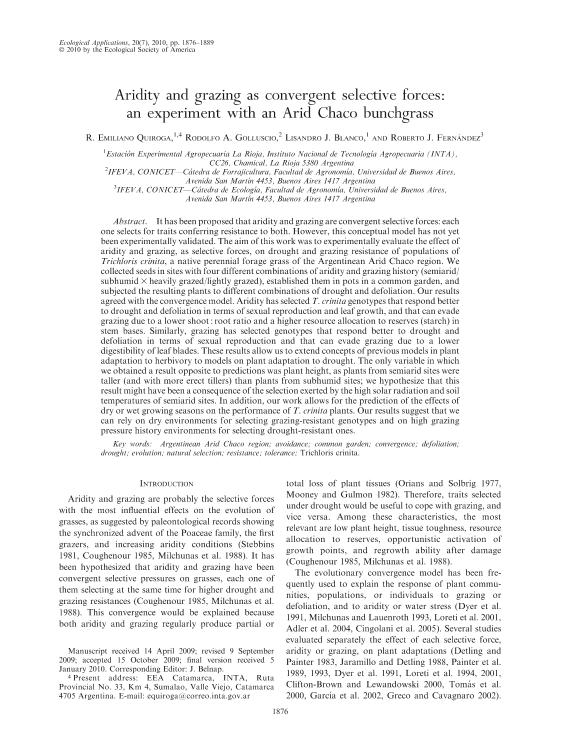Artículo
Aridity and grazing as convergent selective forces: An experiment with an Arid Chaco bunchgrass
Fecha de publicación:
10/2010
Editorial:
Ecological Society of America
Revista:
Ecological Applications
ISSN:
1051-0761
Idioma:
Inglés
Tipo de recurso:
Artículo publicado
Clasificación temática:
Resumen
It has been proposed that aridity and grazing are convergent selective forces: each one selects for traits conferring resistance to both. However, this conceptual model has not yet been experimentally validated. The aim of this work was to experimentally evaluate the effect of aridity and grazing, as selective forces, on drought and grazing resistance of populations of Trichloris crinita, a native perennial forage grass of the Argentinean Arid Chaco region. We collected seeds in sites with four different combinations of aridity and grazing history (semiarid/subhumid × heavily grazed/lightly grazed), established them in pots in a common garden, and subjected the resulting plants to different combinations of drought and defoliation. Our results agreed with the convergence model. Aridity has selected T. crinita genotypes that respond better to drought and defoliation in terms of sexual reproduction and leaf growth, and that can evade grazing due to a lower shoot : root ratio and a higher resource allocation to reserves (starch) in stem bases. Similarly, grazing has selected genotypes that respond better to drought and defoliation in terms of sexual reproduction and that can evade grazing due to a lower digestibility of leaf blades. These results allow us to extend concepts of previous models in plant adaptation to herbivory to models on plant adaptation to drought. The only variable in which we obtained a result opposite to predictions was plant height, as plants from semiarid sites were taller (and with more erect tillers) than plants from subhumid sites; we hypothesize that this result might have been a consequence of the selection exerted by the high solar radiation and soil temperatures of semiarid sites. In addition, our work allows for the prediction of the effects of dry or wet growing seasons on the performance of T. crinita plants. Our results suggest that we can rely on dry environments for selecting grazing-resistant genotypes and on high grazing pressure history environments for selecting drought-resistant ones.
Archivos asociados
Licencia
Identificadores
Colecciones
Articulos(IFEVA)
Articulos de INST.D/INV.FISIOLOGICAS Y ECO.VINCULADAS A L/AGRIC
Articulos de INST.D/INV.FISIOLOGICAS Y ECO.VINCULADAS A L/AGRIC
Citación
Quiroga, R. Emiliano; Golluscio, Rodolfo; Blanco, Lisandro Javier; Fernández, Roberto J.; Aridity and grazing as convergent selective forces: An experiment with an Arid Chaco bunchgrass; Ecological Society of America; Ecological Applications; 20; 7; 10-2010; 1876-1889
Compartir
Altmétricas




